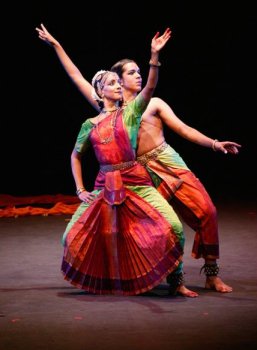
Drishya
Kaavyam Kautvam: A noteworthy presentation
- Lehkikaa,
California
e-mail: lehkikaa@gmail.com
Photos: Surendra Prakash
September 18,
2009
 A
decent turnout on a Friday evening Sept 11, 2009 at Cubberly Auditorium,
Palo Alto, was ample proof that Mythili Prakash's debut of the Drishya
Kaavyam production was eagerly awaited by the serious rasikas of bay area,
CA. It was indeed a treat to the eyes; almost every piece had the dancers
in different costumes, and every group piece was a visual delight. The
pace throughout was...well, Mythili-esque - fast and staccato, a shot of
mental caffeine. The lighting and orchestra deserve special mention, as
both were outstanding. A
decent turnout on a Friday evening Sept 11, 2009 at Cubberly Auditorium,
Palo Alto, was ample proof that Mythili Prakash's debut of the Drishya
Kaavyam production was eagerly awaited by the serious rasikas of bay area,
CA. It was indeed a treat to the eyes; almost every piece had the dancers
in different costumes, and every group piece was a visual delight. The
pace throughout was...well, Mythili-esque - fast and staccato, a shot of
mental caffeine. The lighting and orchestra deserve special mention, as
both were outstanding.
The beginning
of 'Aum, The Sound of Silence' was spellbinding. Shiva (Mythili) was silhouetted
on a pedestal with the dancers assuming various static poses below. As
the music chimed in, some danced while others spun, some others paused
while the rest performed frantic nritta. Out of this clamor arises Shiva,
with his damaru punctuating the chaos. However, the damaru sounds were
not heard above the orchestra; this could've easily been achieved by the
percussionist. Also, the narration stated that the piece was about the
sound of silence, yet, that was the only thing not heard. What was sorely
missed was the Aum - the effect of pulsating silent vibration. Were it
not for this conflict between title plus description, and the rendition,
the first item would be faultless.
'Surya Kanti
Nalini,' the blossoming lotus was well conceptualized; the group seemed
to hold their own without Mythili. Some of the formations were refreshing.
The flower was multi-layered, and the most lotus-like of all stage depictions.
The blossoming was explored individually, and in teams, keeping time with
a fast and then faster beat. More lighting effects can be experimented
with, here.
'Prithika'
deserves a thorough critique, because it shows promise of being a great
piece. The idea of showcasing paths to Divine Love always holds appeal.
Choreographed as a solo, Mythili first portrayed the jeevatma transforming
to paramatma: Radha-Krishna's sensual devotion to one another, via the
ashtapadi "Kuru Yadunandana." Mythili's portrayal was more youthful than
the usual quiet presentation of shringara, but held true to the spirit
of familiarity between the lovers. One could feel Krishna's presence by
how Mythili showed herself being lifted by him.
 The
choice of the Taj Mahal as the next showcase piece was an indicator of
the originality that drives Mythili to excellence. Shah Jahan's pining
for Mumtaz Mahal was well depicted, the highpoint being, him resting his
head on her tomb. The piece was set to Jagjit Singh's "Hoton Se Chulo Tum,"
which, while a match in its mood was not a match in the lyrics - Shah Jahan's
was a pining for the dead lover, not the elusive lover (the song talks
about "ban jao meet mere"/ be my lover). A humming of the soulful melody
might have been more appropriate here, also because a comparison to Jagjit
Singh's stirring original is inevitable. Showing Mumtaz Mahal reaching
down from her spiritual self was a touching tribute to divine love. The
jarring note though was that Shah Jahan reaches for her hand and places
it on his head, a distinctly South Indian gesture. It would be more in
keeping with the Islamic practice to place it on his cheek or even touch
his lips to it. Mythili's interjection of the lines in between the pieces
"...take away everything that takes me away from you...", while innovative,
because it was in English, seemed repetitive. She could've used the same
words but done it Bharatanatyam sanchari style - different gestures to
depict the same meaning. The use of the dupatta was excellent symbolism. The
choice of the Taj Mahal as the next showcase piece was an indicator of
the originality that drives Mythili to excellence. Shah Jahan's pining
for Mumtaz Mahal was well depicted, the highpoint being, him resting his
head on her tomb. The piece was set to Jagjit Singh's "Hoton Se Chulo Tum,"
which, while a match in its mood was not a match in the lyrics - Shah Jahan's
was a pining for the dead lover, not the elusive lover (the song talks
about "ban jao meet mere"/ be my lover). A humming of the soulful melody
might have been more appropriate here, also because a comparison to Jagjit
Singh's stirring original is inevitable. Showing Mumtaz Mahal reaching
down from her spiritual self was a touching tribute to divine love. The
jarring note though was that Shah Jahan reaches for her hand and places
it on his head, a distinctly South Indian gesture. It would be more in
keeping with the Islamic practice to place it on his cheek or even touch
his lips to it. Mythili's interjection of the lines in between the pieces
"...take away everything that takes me away from you...", while innovative,
because it was in English, seemed repetitive. She could've used the same
words but done it Bharatanatyam sanchari style - different gestures to
depict the same meaning. The use of the dupatta was excellent symbolism.
The third snippet
was the fusion of male and female energies in Ardhanari. Taken in isolation,
it was great. It was a visual feast to see the superb choreography giving
the illusion of two divinities fusing and dancing in tandem. However, it
took a while to get used to the fast pace after the gentle touch of the
preceding song. She should have this be a stand alone piece and look for
a different third love-couple or another Ardhanari song to complete the
trio in her Prithika.
'Dashavataram'
right after the intermission, was steroid-fast. It was superbly choreographed
and presented, highlights being the depiction of Rama's life in couplets;
Parashurama's ending; and Kalki avataram. 'Current' was a marvel to watch,
and with all of Mythili's pieces, one needed to catch one's breath at the
end. It could have been christened better, though...even Currents would
be a better title. Nobody said 'Swara Lahiri' was going to be just the
orchestra; one kept waiting for the dance to begin. Since it was designed
as an audio piece, they should've identified the raga first; the presentation
was good but not superlative. A long strip of cloth could be used here,
to show the movement of currents, and depict petals/ lake surfaces as the
wind presses down on them, to make for more visual allure.
The thunder
from "Khuda Ki Tasveer" was stolen by other dancers dancing to other Sufi
songs in the years past. The notable difference here was the singing. Flautist
Mahesh Swamy somehow coaxed a Nusrat sound from within himself. The qawaali-esque
clapping and vocal support was impressive. Mythili could've used more dancers
here, especially at the end; it would've been diverting to watch several
dancers doing the Sufi trance-twirling.
All in all,
Drishya Kaavyam was a noteworthy presentation. Mythili has a sense for
drama. With some tightening of the storyboards and more props to heighten
the visual poetry already accentuated by great lighting effects (if it
is drishya kaavyam, then more attention must be paid to the drishya elements),
it will blossom into a memorable production.
Lehkikaa is a dance and drama
critic at large in the Bay Area. |


 A
decent turnout on a Friday evening Sept 11, 2009 at Cubberly Auditorium,
Palo Alto, was ample proof that Mythili Prakash's debut of the Drishya
Kaavyam production was eagerly awaited by the serious rasikas of bay area,
CA. It was indeed a treat to the eyes; almost every piece had the dancers
in different costumes, and every group piece was a visual delight. The
pace throughout was...well, Mythili-esque - fast and staccato, a shot of
mental caffeine. The lighting and orchestra deserve special mention, as
both were outstanding.
A
decent turnout on a Friday evening Sept 11, 2009 at Cubberly Auditorium,
Palo Alto, was ample proof that Mythili Prakash's debut of the Drishya
Kaavyam production was eagerly awaited by the serious rasikas of bay area,
CA. It was indeed a treat to the eyes; almost every piece had the dancers
in different costumes, and every group piece was a visual delight. The
pace throughout was...well, Mythili-esque - fast and staccato, a shot of
mental caffeine. The lighting and orchestra deserve special mention, as
both were outstanding.